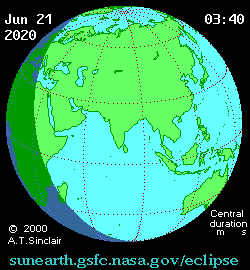From our perspective here on Earth, one of the most spectacular celestial dances appears when the Moon partially obscures our view of the Sun, allowing a ring of star fire to escape its edges. And on June 21, that's exactly the show we'll be getting.
The phenomenon is called an annular solar eclipse. It happens when the Moon is farthest away from Earth in its orbit, and therefore appears smaller in our skies relative to the Sun.
That small difference in apparent size is what sets annular eclipses apart from full solar eclipses, when the closer position of the Moon (with its average radius of 1,800 kilometres or 1,000 miles) makes it appear to be the same size as our far larger star, which has a radius of around 696,000 kilometres (432,000 miles).
A stunning - and unusual - example of this was captured by photographer Colin Legg and astronomy student Geoff Sims in Western Australia in May 2013.
In this case the ring of fire is also distorted by Earth's atmosphere, squashing the extraordinarily synchronised Moon and Sun as they rise, until they climb above the level of high refraction.
This weekend, a complete 'ring of fire' will be visible from central Africa and through Asia, commencing at 0345 UTC on 21 June 2020. Many other locations, from southeastern Europe to the northern tips of Australia, will experience a partial annular eclipse.
The shadow moving across the image below indicates where at least a partial eclipse will be visible and the moving dot marks the line of totality - the path along which the annular eclipse will last the longest.
 The June 2020 eclipse path. (NASA)
The June 2020 eclipse path. (NASA)
At the peak of the eclipse, the Moon will block 99.4 percent of the Sun as the pair graces the skies of northern India.
If you're planning to catch the sight yourself, more detailed maps for each location can be found at Time and Date.
NASA notes you can be hundreds of miles from the line of totality and still enjoy an incredible view - just as long as the sky is clear enough, of course.
Unfortunately, due to the pandemic circumstances with restricted travel, hardcore eclipse chasers will probably have to sit this one out. But we're certain those lucky enough to be along the line of totality will take the opportunity to capture the spectacular view and share it with the rest of us.
Several groups have planned livestreams so we all can witness the event as it happens, including Time and Date and the Virtual Telescope Project, which will begin broadcasting from 0530 UTC, 21 June 2020 (10:30 pm PT Saturday night).
The last annular eclipse took place late 2019, and the images did not disappoint:
after several months of work, i am glad to share my large FOV image of the #solareclipse2019 observed from @cerrotololo ! this was made possible thanks to @NikonFR and @cieletespace. More information on my website:https://t.co/LMfTuAwr4p pic.twitter.com/5kgeQhytLN
— Nicolas Lefaudeux (@NLefaudeux) January 29, 2020
"It's only two minutes, but it's so intense that you talk about it with your friends, family for the next month," said geophysicist Alexander Alin, who observed the 2019 event in person.
After this weekend, the next ring of fire will occur in 2021, but will mostly be visible in its entirety only from the Arctic. However, a total solar eclipse will cross South America later this year.
#Space | https://sciencespies.com/space/a-breathtaking-ring-of-fire-solar-eclipse-will-adorn-our-skies-this-weekend/
No comments:
Post a Comment